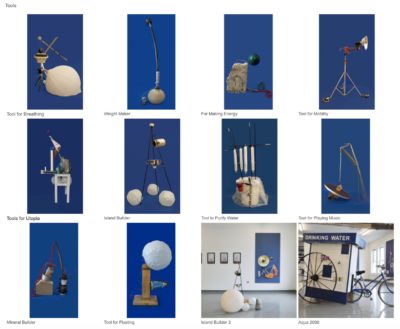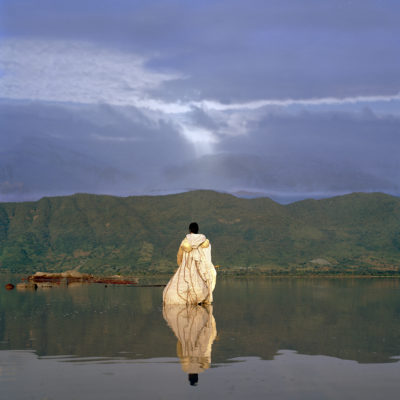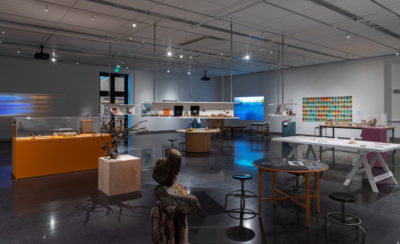Considering Utility
January 9, 2021
Text by Mo Geiger with Mary Mattingly
“It starts as something I need or desire access to: whether it’s fresh food in NYC, clean drinking water, or a living space.”
Mary Mattingly is a contemporary artist currently living in Brooklyn, NY. She was born in Rockville, Connecticut. In her work, she builds living systems or ecosystems, often by transforming industrial equipment and personal objects. Creating projects around the world, Mary examines the way humans interact with natural and manufactured resources: initiating ideas, models, and evidence for imaginative community-based economies.
In this conversation, I wanted to ask Mary about her response to this year’s social, environmental, and physical circumstances. I am interested in the ways she incorporates tools and motion into her art projects, creating connections between the activities of life and the materials we use to sustain it. During the pandemic, I’ve spent a lot of time considering human and material movement, and Mary’s work explores this subject extensively. Growing up in a mobile home, she came to understand mobility as a choice or a necessity, reflecting now on the ways mobility has come into focus recently. One of her early projects, Tools (2008-2012), encapsulates tasks such as “floating,” “breathing,” and “island-building” into prototypical concept-objects. Wearable Homes (2004-ongoing) utilizes layers of specific performance fabrics and body-sensing technology to create individual ecosystems that could ultimately be linked together with other wearers to create “wearable cities.”
Both of these projects exhibit a commitment to living systems that activate the human body within various contexts, and they position individual people in relation to a collective, communal whole. Both projects view utility in playful ways, by imagining situations or extreme that require adaptive, portable shelters. These works ultimately led to some of her later projects involving water and natural ecosystems. Recently, in her 2020 works A Year of Public Water and Ecotopian Library, Mary builds on those early experiments in systems, form, and utility by collecting information and objects through interdisciplinary methods of research and presentation.
This interview was conducted in writing during November of 2020.
Mo Geiger: What is your favorite tool, and do you remember who taught you how to use it?
Mary Mattingly: It’s probably a toss-up between tools for physical building and tools for communication. I’d have to say that a writing utensil is by far my favorite tool (although I use a computer equally as much). Since I can make a writing utensil, there’s a sense that this is something I’ll almost always have access to, and I feel an affinity for it. It was probably my mother who taught me how to use one. A close second is one my father taught me to use: he had a Pentax K1000 and taught me how to use a film camera when I was young. Now I often use a digital Nikon and a Hasselblad camera, and I can say a camera is my second favorite tool.
Mo: In your project Tools, you used objects to replicate and reimagine systems for survival. In Wetland, you combined many tools and systems into one living space on a boat. The act of examining systems can easily appear academic or pedantic, but to me, your work does not—how do you hold onto (and amplify) imaginative and playful elements of your projects?
Mary: Since Wetland was a living space, its survival systems were in use and constantly in flux. The Tools series was more provocative and suggestive—they questioned what a tool could be. I suppose my objective in both projects was to creatively interpret systems (tools or living systems). The living systems in Wetland needed to work, but that wasn’t the point in Tools. They interpreted tools as broad-ranging. My approach to both (and to most things) was to use materials with a previous life or recognizable use, and repurpose them in somewhat absurd ways. These projects are rarely perfectly designed living systems, but instead cobbled-together approaches to appropriate technologies.

Mo: In your Wearable Homes project, I was struck by how you describe the users as “voyagers.” Can you tell me about that project and what inspired it?
Mary: In 2001, I started making wearable sculptures that embodied my personal concerns about a growing lack of access to clean water and paired them with future speculations about sea level rise and ecological instability. As both a climate change prediction and an assumption that more people will lack access to basic resources, the Wearable Homes project began as a useful suit for navigating through harsh, desertified terrains, and later bordered on more absurd dystopic commentary about what consumption might look like—after most everything imaginable had been marketized and sold. I often called people “navigators” as well. While the Wearable Homes project assumed one set of dystopic future conditions based on a dominant extractive culture, it also fetishized the idea of alienation brought on by electric technologies that led to physical separation; narrative introduced that separation. So for example, while Wearable Homes contained electric technologies, they also contained tools like “island builders,” which would suck sand from one place and bring it to another, so a person could make her own island.
Mo: In what ways has this period of quarantine and shelter-in-place earlier this year affected the ways you think about human movement through space and time?
Mary: Before, I was responding to a dystopic assumption that constant use of electric technologies for communication makes people become less familiar with communicating in person, so people start to move toward physical distance from each other. Of course, the pandemic has created another set of conditions for separation. It did strike me that the roles of “reachers” and “receivers” in Wearable Homes would be useful in the time of Coronavirus physical distancing. These were sewn into the back of the suit, and they were supposed to be used instead of touching another person with a body part. It was an extension of technological predictions that there would be a future in which people touched each other less and communicated via machines. Of course, now people have been moving safely amongst each other for some time with masks and without being in enclosed spaces for prolonged amounts of time, so while I’m not sure human movement through space and time will change much, I’m much more aware of how quickly a pandemic can spread through people and also how that spread can be mitigated.

Mo: Two of your projects this year, A Year of Public Water and Ecotopian Library, attempt a similar task of examining systems, but they do it on a broader scale. In what ways did those earlier projects regarding tools and experimental living space inform your interest in research and archiving?
Mary: I went from having access to undrinkable water as a young person, living 2.5 hours away from New York City, to living in Brooklyn as an adult where I have access to a healthy watershed. So I’m dependent on New Yorkers who live within the watershed to protect the drinking water for the city. Public Water is a project that starts to explore these relationships as life partnerships that need to be more equitable. So there is a website that is a repository for interviews, accumulated knowledge about the watershed (sourcing from preexisting archives), and artists who work with the watershed. More than it being an archive, it’s a way to activate interest and concern for this essential part of life that often goes unrecognized.
Ecotopian Library is a cross between a contemplative exhibition and a tool library that combines art, literature, and poetry with political histories, social utopian studies, earth sciences, forestry and TEK (traditional ecological knowledge)(1). It contributes to what I’ll call ecotopian subject-making. I wanted to begin building something like this to glean from these tools how to imagine other ways of doing and being. These projects were both informed by deep research I’d been doing into the photographic supply chain, and specifically cobalt, which is in the digital camera I use.
Mo: Does “ecotopian subject making” relate to using narrative as an artistic method? In your work, I see an exchange between real and imagined scenarios, in addition to a recurring fascination with transformation over time.
Mary: I think with all of these projects, it starts as something I need or desire access to: whether it’s fresh food in NYC, clean drinking water, or a living space, it’s no different with the Ecotopian Library. I desired access to the tools I imagined could be found inside of it.
Mo: What is the role of collecting and archiving knowledge (and tools) in a nomadic existence? How do we collect, archive, and use knowledge as we’re often on the move, adapting?
Mary: Well, let me just say that the Wearable Homes project was something that I worked on through 2006. At that point the wearables grew into small living spaces for multiple people, and these have often been mobile. With the Ecotopian Library, I’m working towards a permanent home for it, but it’s a place where people can visit for bouts of time and don’t permanently live there. These are all places of exchange (with visitors from “outside” coming in, and neighbors). I’d say the most important part of collecting and archiving is the exchange.

Mo: Did your approach to these projects (A Year of Public Water and Ecotopian Library) change as the events of this year unfolded, as failures of existing systems became more blatant?
Mary: What drives me to include water in much of the artwork I do, and to follow the business of water privatization, was when around the year 2000 [prior to beginning work on Wearable Homes], when [engineering and construction company] Bechtel, with the World Bank, privatized water in Bolivia, which made the water unaffordable for most people. In Cochabamba, tens of thousands of people protested, until unrest led the government to revoke those water contracts. Since then, water privatization has been something I’ve followed closely. So in the beginning of the pandemic when water was being turned off in Detroit, the effects of hollowing out state and national support for basic needs was more apparent than ever.
(1) TEK, an abbreviation of “traditional ecological knowledge,” is a term that “encompasses a subset of traditional knowledge maintained by Indigenous nations about the relationships between people and the natural environment.” This description can be found in an article titled “The Value of Traditional Ecological Knowledge for the Environmental Health Sciences and Biomedical Research,” which was published in Environmental Health Perspectives in 2017. View the full text here.
Mary Mattingly is a visual artist who lives in Brooklyn, NY. She founded Swale, an edible landscape on a barge in New York City. In 2017, Swale instigated and co-created the “foodway” in the Bronx’s Concrete Plant Park. The introduction to her 2015 manifesto states: “Art and utopian thought can cultivate systemic social change. Art can transform people’s perceptions about value, and collective art forms can reframe predominant ideologies.” For more information about her artwork, exhibitions, and publications, visit marymattingly.com
Mary Olin (Mo) Geiger makes collaborative artworks and performances that emphasize tactile, interdisciplinary processes and the act of searching. She is an MFA candidate in Portland State University’s Art and Social Practice makes collaborative artworks and performances that emphasize tactile, interdisciplinary processes and the act of searching. She is an MFA candidate in Portland State University’s Art and Social Practice Program. For more information, visit mogeiger.com


